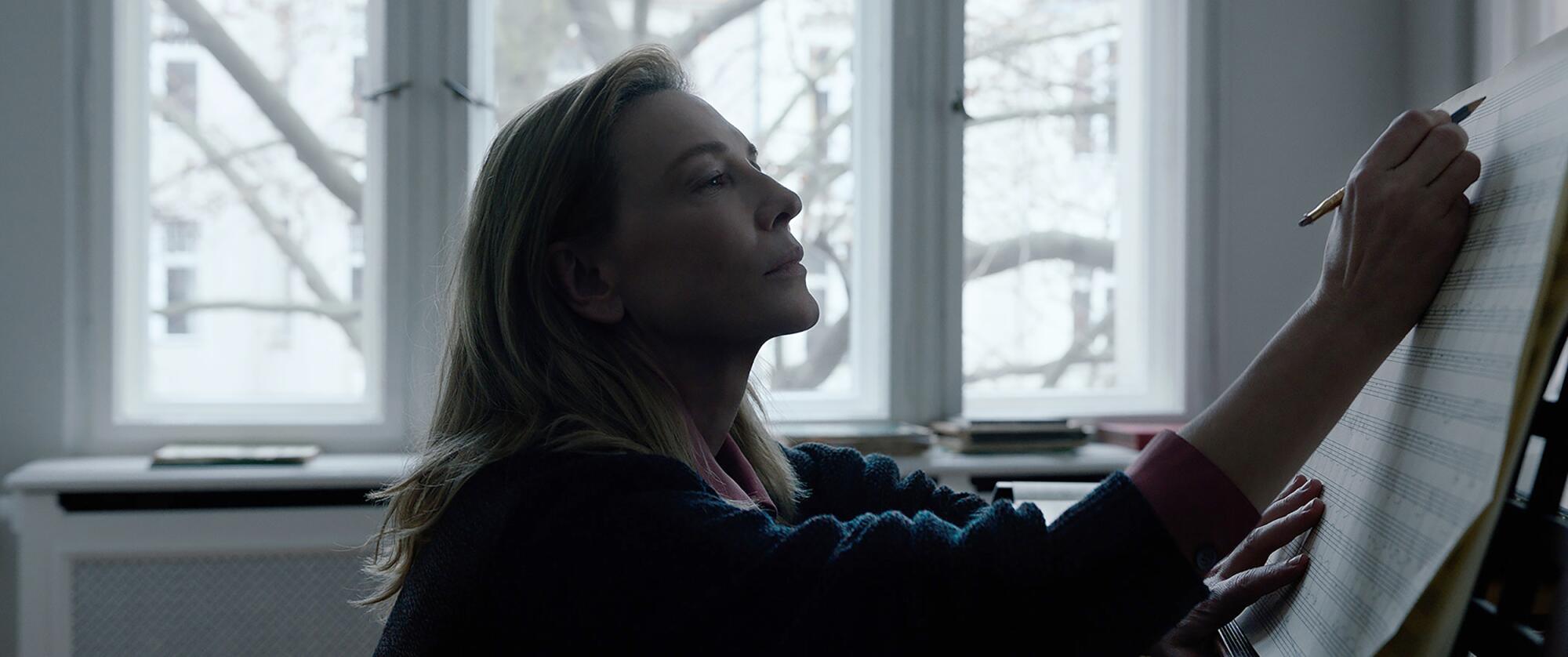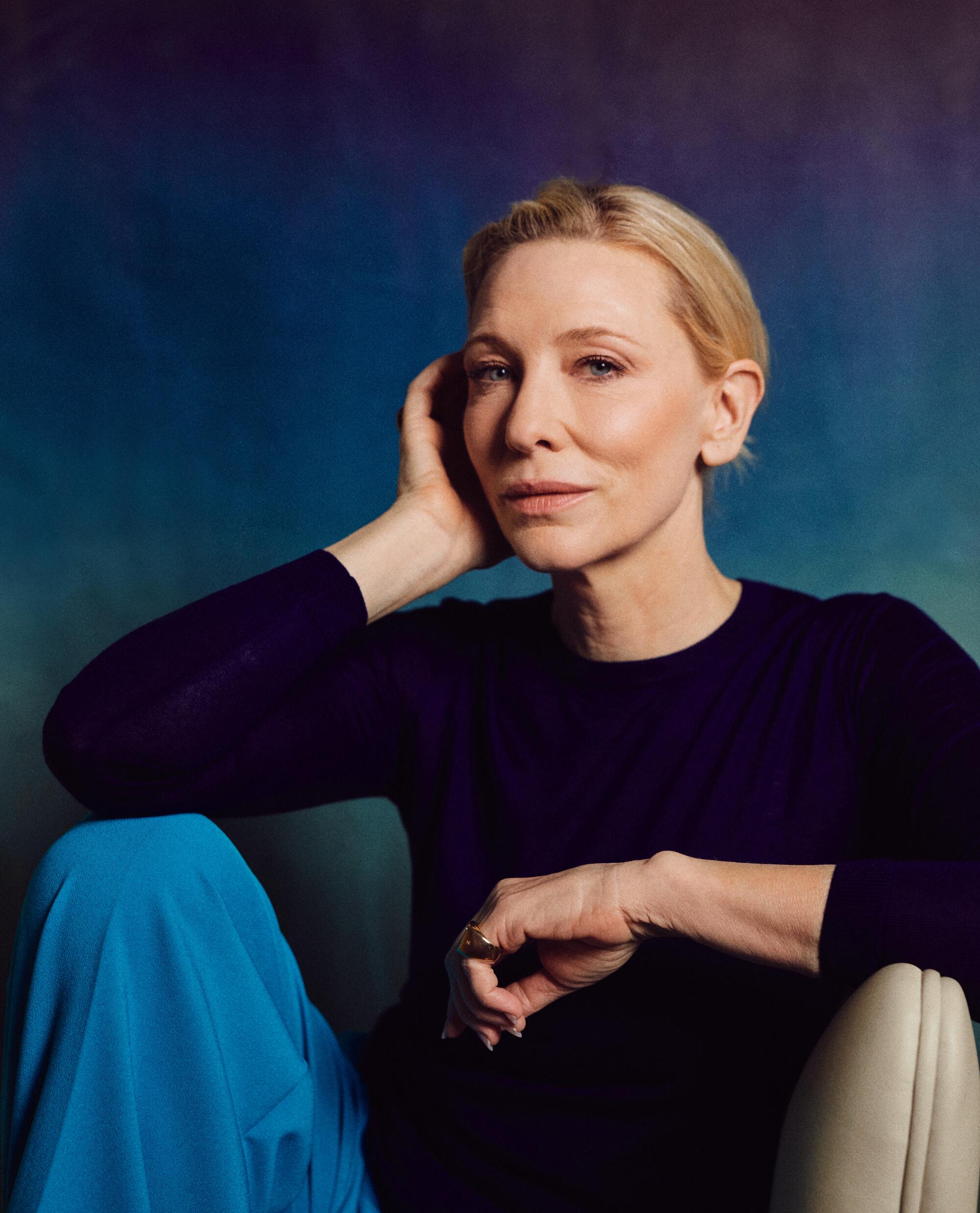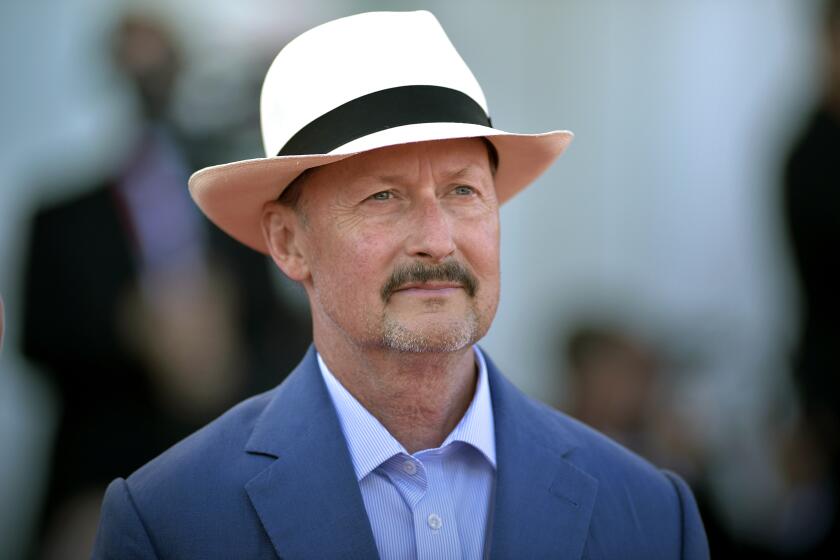- Share via

Cate Blanchett hasn’t watched “Tár” since its premiere at the Venice Film Festival in September. She saw it only one time before, when writer-director Todd Field was ready to show it to her. But it was in Venice, where “Tár”received a thunderous ovation, that she felt something stir inside her. “It started to be painful — I was like, ‘I don’t need to see this anymore,’” she says. “What I’ve learned from it and the takeaway from it, I can’t watch it anymore.”
The 53-year-old actress is known for not revisiting her work, which doesn’t mean she isn’t immensely proud of what she and her fellow artists created. Indeed, since September she’s been barnstorming for “Tár,” a bottomlessly fascinating study of a powerful, feared conductor, Lydia Tár, whose hubris and past sins orchestrate her downfall. Earning her eighth Oscar nomination — she won supporting actress for “The Aviator” and lead actress for “Blue Jasmine” — Blanchett is at the pinnacle of her profession, delivering what may be her finest performance yet. But none of that makes it easier to talk about what it was like to make “Tár.”
“It’s almost like we made the film in an unconscious state,” she offers, fighting off the chill of an overcast February afternoon while seated on the rooftop of the Maybourne hotel in Beverly Hills. “We were waking up and saying [to the audience], ‘You know this fever dream we’ve had? That thing that we thought we did, is that how you responded to it?’”

Her memories of “Tár” remain potent: how Field sent her the script, saying that he wouldn’t make it with anyone else; how during her research she’d awake in the middle of the night, only to discover that she had been conducting in her sleep. Now, though, her experience must give way to the audience’s as it takes possession of “Tár,” which she’s thought about a lot.
For the record:
12:15 p.m. Feb. 28, 2023An earlier version of this article attributed a quote to writer Peter Brooks. It is from theater director Peter Brook.
“[Theater director] Peter Brook says this wonderful thing: You hang on tightly and you let go lightly,” Blanchett observes. “I’ve become better at letting go lightly. But I do look back on the thing, the object, with a touch of melancholy.”
Often during our hourlong conversation, Blanchett will apologize — for being tired, for getting weepy while discussing the film version of “Death in Venice,” for what she perceives as her talking too much. (At one point, she laments, “I will walk away from here yet again saying to myself, ‘Just answer the question. This is not a conversation.’”) As imposing as her performances can be, there’s a touching self-consciousness to her in person — a fragility, a vulnerability — that’s quite disarming. And despite her protestations that she rambles, when Blanchett lets her mind roam free, that’s when the really beautiful insights emerge.
Take, for instance, in the midst of describing Lydia’s complicated relationships, Blanchett eventually arrives at: “Have you ever had this experience — maybe it’s a moment of shame [from] something that you regret doing — but [the memory of it] will often come back to me when I’m driving. It’s like, ‘Why did I say that? What an idiot.’ The thought will come into your head, and all of a sudden you’ll start singing a song to push the remembrance of that event from you? I started to think of music as a way of Lydia pushing her past — or things that she just couldn’t face — out of her mind. The very thing that had been a liberating force in her life was becoming a force that was allowing her not to look at herself, her past and her present circumstances.”
Because “Tár” is a film filled with ambiguities, it’s understandable that audiences and journalists would look to her to explain what they’ve just seen. But Blanchett says that hasn’t really happened — much to her relief. “Mostly, I’ve listened to people who’ve wanted to talk about it, with very little to say myself,” she notes. “I don’t want to get in the way of whatever they brought to the cinema that day. I mean, you look at a Rothko and you go, ‘Rothko doesn’t want to get in the way.’ [Film] is very different, but these works, they vibrate — they’re very resonant. There’s no ‘right’ reading of these works.”
How Todd Field spent hours and hours studying classical music and orchestras before writing his Oscar-nominated screenplay.
Still, Blanchett and her superb co-stars — including Noémie Merlant as Lydia’s long-suffering assistant Francesca and Nina Hoss as Lydia’s weary wife Sharon — had to make peace with letting the script’s unanswered questions remain riddles. “We didn’t pin things down. For example, what happened between [Lydia’s former protégé] Krista and Francesca and Lydia? I remember seeing Noémie on set — we’d raised the question when we sat around the [rehearsal] table — and I remember catching her eye, and I know that we were both thinking, ‘Should we talk about this?’ And we thought, ‘No.’”
The amount of prep that went into her performance has been well documented. Learning German. Becoming more confident on the piano after having abandoned it as a child. Immersing herself in classical music. But such dutiful recitations can overshadow the impromptu adventures that happened on set. Like when she was told one day that the accordion teacher was waiting for her.
“Todd asked me in preproduction: Did I play the accordion? And I said, ‘What do you think? No,’” she recalls with a laugh. “I said, ‘Do you want me to play?’ And he said, ‘No, no, no.’ And then [during the shoot] Sebastian [Fahr-Brix], the first AD, said, ‘The accordion teacher’s here. Todd wants you to go and sit with the accordion teacher.’”
Confused, she met with Field. “He said, ‘Yeah, you picked up the accordion, right?’ And I went, ‘You said no! I was conducting and learning piano and working with [composer and cellist] Hildur [Guðnadóttir]. No, I haven’t picked up the accordion!’ And he said, ‘Just go and work with it for half an hour.’”
Which is how we got the supremely meme-able moment in which the usually ultra-serious Lydia walks into frame, accordion strapped to her chest, improvising a goofy ditty called “Apartment for Sale.” Blanchett remains deeply amused by the scene. “We did about four takes of it,” she beams. “The rest of the crew, they were looking at each other like, ‘I think Cate and Todd have finally lost their s—.’ He and I were in tears laughing. But that epitomized the collaboration: We would talk and talk and talk, and then suddenly we’d make these really quick decisions.”

In interviews, she sometimes ponders stepping away from acting. It’s hard to know how serious she is — after all, who among us doesn’t need to occasionally give voice to the idea of hanging it up, if only to periodically check in with ourselves? Still, she says of her vocation, “It’s not always a comfortable place to be. It’s very hard sometimes to say no. And sometimes it’s equally as hard to say yes because I have four kids who I am passionate about. I’ve been married for 26 years, and it’s the most important relationship in my life. I have a parallel existence that I don’t want to cannibalize in my work, and I don’t want my work to cannibalize it. I feel incredibly blessed in that way.”
But then the self-critical part of herself pops up again. “You constantly feel like you’re failing both of those relationships, don’t you?” she asks, almost conspiratorially. “The creative relationship and your [personal] relationship. It’s not that I don’t love [acting] — it’s just that it’s …” Another pause. “It’s a very noisy world.” She thinks about all the interviews she gives, how she sometimes will say something to see how it feels to put it out in the air, only to see it later in print, presented forever as some sort of truth. “It feels very disingenuous in this exchange but, yes, I’m constantly wanting to be quiet.”
It’s been nearly six months since Blanchett sat down and watched “Tár,” but that hasn’t stopped fans from repeatedly revisiting the film, hoping to eventually unravel its riddles. She is learning how to let the movie go lightly, which leaves room for others to discover things inside it.
“I was speaking to someone this morning — we were talking about something else entirely, this project we’re doing together — and then he said, ‘OK, just want to ask you a question [about] “Tár.” So the thing where she goes back to her house and she gets the [Leonard] Bernstein tapes out …’”
We’ll omit the rest of what this person said to Blanchett to avoid spoilers — but, suffice it to say, there’s a clue within that scene about Lydia’s nature that many viewers missed. Blanchett’s colleague noticed it, though, and was very excited. So was Blanchett. Recounting this anecdote now, she’s positively glowing, happy to let “Tár” at last speak for itself.
“I went, ‘You got that?!’ I haven’t seen Todd since I’ve had that meeting this morning, but he’ll be so thrilled. It’s those little details that you don’t need to overplay. An audience will pick them up.”

More to Read
Sign up for The Envelope
Get exclusive awards season news, in-depth interviews and columnist Glenn Whipp’s must-read analysis straight to your inbox.
You may occasionally receive promotional content from the Los Angeles Times.








